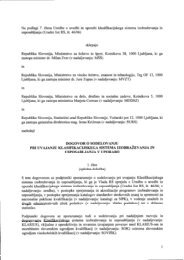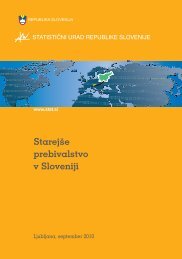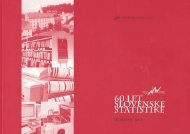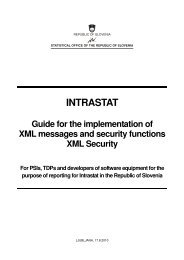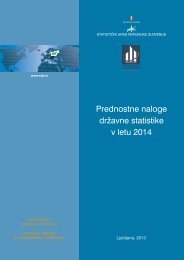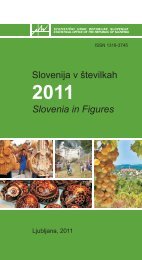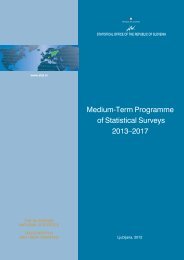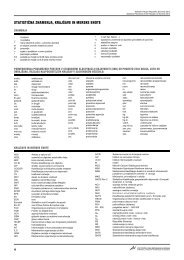Slovenske regije v Å¡tevilkah - StatistiÄni urad Republike Slovenije
Slovenske regije v Å¡tevilkah - StatistiÄni urad Republike Slovenije
Slovenske regije v Å¡tevilkah - StatistiÄni urad Republike Slovenije
Create successful ePaper yourself
Turn your PDF publications into a flip-book with our unique Google optimized e-Paper software.
Statistična regija jugovzhodna Slovenija<br />
Ogledalo <strong>regije</strong><br />
{ifra, ime ob~ine / code & name of municipality<br />
017 ^rnomelj<br />
157 Dolenjske Toplice<br />
048 Ko~evje<br />
165 Kostel<br />
066 Lo{ki Potok<br />
073 Metlika<br />
170 Mirna Pe~<br />
199 Mokronog - Trebelno<br />
085 Novo mesto<br />
088 Osilnica<br />
104 Ribnica<br />
109 Semi~<br />
179 Sodra‘ica<br />
203 Stra‘a<br />
119 [entjernej<br />
211 [entrupert<br />
121 [kocjan<br />
206 [marje{ke Toplice<br />
130 Trebnje<br />
193 @u‘emberk<br />
Ta regija na jugovzhodu <strong>Slovenije</strong>, po povr{ini najve~ja slovenska regija, povezuje v enoto {tiri<br />
pokrajine: de‘elo suhe robe, de‘elo ko~evskega medveda, de‘elo cvi~ka in de‘elo zelenega Jurija.<br />
Njen razvoj omogo~a v najve~ji meri industrija (avtomobilska, farmacevtska in druga lahka<br />
industrija); ta je leta 2007 ustvarila skoraj polovico bruto dodane vrednosti v tej regiji. Po vrednosti<br />
vlaganj na prebivalca so tukaj{nja podjetja, dru‘be in organizacije na tretjem mestu v Sloveniji,<br />
~eprav njihove bruto investicije v nova osnovna sredstva na prebivalca ne presegajo dr‘avnega<br />
povpre~ja. Pomembno vlogo ima tudi raziskovalno-razvojna dejavnost; v letu 2007 so izdatki<br />
zanjo zna{ali kar 2,8 % BDP te <strong>regije</strong>. Finan~na sredstva za to dejavnost so skoraj v celoti prispevale<br />
gospodarske dru‘be. Stopnja brezposelnosti v tej regiji je bila ni‘ja od slovenskega povpre~ja;<br />
manj ugodna pa je bila tu izobrazbena struktura brezposelnih (ve~ kot polovica teh oseb je namre~<br />
imela najni‘jo stopnjo izobrazbe). Znatno ugodnej{i so prebivalstveni kazalniki. V letu 2008 se je<br />
regija po prirastu prebivalcev povzpela na tretje mesto v dr‘avi, k nadpovpre~ni rasti {tevila<br />
prebivalcev pa je prispevalo predvsem priseljevanje. Dele‘ mladih (0–14 let) je bil tu glede na<br />
preostale <strong>regije</strong> {e vedno najve~ji, vendar je bil ‘e manj{i od dele‘a oseb v starosti 65 let ali ve~<br />
(15,6 %). Kljub temu je povpre~na starost prebivalcev jugovzhodne <strong>Slovenije</strong> najni‘ja v dr‘avi<br />
(leta 2008 je bila za ve~ kot 2 leti ni‘ja od povpre~ne starosti prebivalcev v obalno-kra{ki regiji).<br />
This region in the south-east of Slovenia is the largest region in the country and incorporates four<br />
distinct parts: the land of woodenware, of the brown bear, of light red wine Cvi~ek and of Zeleni<br />
Jurij (Green George). The development of this region is largely the result of industry (car industry,<br />
pharmaceutical industry and other light industry) as it created almost a half of gross value added<br />
in the region in 2007. Enterprises, companies and organisations are third in the country according<br />
to per capita gross investments in new fixed assets, although these investments do not exceed the<br />
national average per capita gross investments. The expenditure on research and development<br />
(R&D) amounting to 2.8% of the regional GDP in 2007 underlined the importance of R&D in the<br />
region. The main sources of financing were business enterprises. This region had lower registered<br />
unemployment rates than the national average. However, the structure of unemployed was less<br />
favourable since more than half of them had the lowest level of education. Population indicators<br />
are much more favourable. In 2008 the region was third regarding population increase which<br />
mainly increased due to immigration. The share of young people (aged 0-14) was still the highest<br />
in the country, although it was already lower than the share of people aged 65 and more (15.6%).<br />
Despite that, the mean age of population in Jugovzhodna Slovenija is the lowest; in 2008 it was<br />
almost 2 years lower than the mean age of population in Obalno-kraška.<br />
Povr{ina, km 2 , 31. 12. 2008 2.675<br />
Area, km 2 , 31. 12. 2008<br />
[tevilo prebivalcev, 31. 12. 2008 141.166<br />
Population, 31. 12. 2008<br />
Gostota prebivalstva, 31. 12. 2008 52,8<br />
Density of population, 31. 12. 2008<br />
[tevilo `ivorojenih, 2008 1.584<br />
Number of live births, 2008<br />
[tevilo umrlih, 2008 1.237<br />
Number of deaths, 2008<br />
Naravni prirast, 2008 347<br />
Natural increase, 2008<br />
[tevilo u~encev, 2008/2009 1) 12.246<br />
Number of pupils, 2008/2009 1)<br />
[tevilo dijakov, 2008/2009 1) 6.890<br />
Number of upper secondary school pupils, 2008/2009 1)<br />
[tevilo {tudentov, 2008/2009 2) 8.270<br />
Number of tertiary students, 2008/2009 2)<br />
[tevilo diplomantov, 2008 2) 1.227<br />
Number of tertiary graduates, 2008 2)<br />
[tevilo delovno aktivnih prebivalcev, 2008 56.880<br />
Number of persons in employment, 2008<br />
[tevilo zaposlenih oseb, 2008 50.679<br />
Number of persons in paid employment, 2008<br />
[tevilo samozaposlenih oseb, 2008 6.200<br />
Number of self-employed persons, 2008<br />
[tevilo registriranih brezposelnih oseb, 2008 4.223<br />
Number of registered unemployed persons, 2008<br />
Povpre~na mese~na bruto pla~a po regiji prebivali{~a, skupaj, 2008 1.371<br />
Average monthly gross earning by statistical region of residence, total, 2008<br />
za mo{ke 1.400<br />
for men<br />
za `enske 1.334<br />
for women<br />
[tevilo podjetij, 2008 8.268<br />
Number of enterprises, 2008<br />
Prihodek podjetij, mio. EUR, 2008 5.962<br />
Turnover of enterprises, mio EUR, 2008<br />
48



